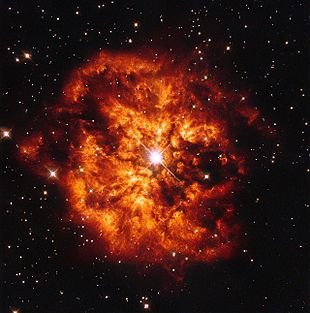Big Bad Binaries and Other X-ray Sources

Yesterday I wrote about binary systems and their components. Sometimes those components can be massive, meaning they have an initial mass greater than 8 solar masses that could lead to an eventual supernova fate. If one or both of the components are massive, then it is considered a massive binary system (Moffat 2008). These tend to be sources of X-ray emissions, but the exact mechanism of their production is poorly understood. One hypothesis is that the X-ray emission is a result of the colliding stellar winds from the two components (Moffat 2008).
Westerlund 1 is dense cluster in the Milky Way galaxy that is full of young massive stars, making it an ideal region to investigate this X-ray phenomenon. In a recent submission to Astronomy & Astrophysics, astronomers reported their findings on attempts to classify members of the Westerlund 1 cluster using the Very Large Telescope's FLAMES spectrograph in Chile. Of 45 X-ray sources, they found 16 as candidate or confirmed massive binaries. Interestingly, the researchers found that X-ray emission was only coming from O9-B0.5 supergiant stars, Wolf-Rayet, and a group of OB+OB binaries.
Let's unpack each of these one by one. It is important to understand the stellar classification system(see Figure 2). As a quick summary, stars are classified by their spectra and grouped in order of their temperature. The hottest stars are type 'O', while the coolest are type 'M'. In between (in order of decreasing temperature) are types: 'B', 'A', 'F', 'G', 'K', 'M'. Each of these types is further divided into 10 subcategories: A0-A-9, where 0 is the hottest and 9 is the coolest temperature. Additionally, a Roman numeral can be added for luminosity where 'I' is a supergiant down to 'VII' for a white dwarf, and everything in between.

So back to our results, 'O9-B0.5 I' are supergiants that are the coolest O stars and the hottest B stars. In this study, these stars were the ones found to emit X-rays. On the other hand, less luminous 'O9-9.5 II-III' (i.e., bright giants and regular giants) did not display X-rays. The authors suggest this X-ray deficit is due to these stars relatively lower luminosity. However, for the B type stars, they state that the same X-ray deficiency could be caused by a decrease in the stellar wind. This is significant because without enough stellar wind, the resulting collisions with surrounding matter would not be strong enough to generate X-rays.
The second group of objects the study found to emit X-rays was Wolf-Rayet (WR) stars (see Figure 1 above). WR stars are rare, massive stars with strong stellar winds that have stripped away their outer shell of hydrogen. Astronomers believe that WR are rarely observed simply because they are a short-lived period of evolution in the life of a massive star. Although the specific properties of WR stars can vary greatly, the detection of X-rays in this group is not surprising because it is consistent with the idea that the X-rays are a result of collisions of the stellar wind with surrounding matter, and WR are known for their strong stellar winds.
The final group the astronomers observed to emit X-rays was OB+OB binaries. As the name implies, these are binary systems in which each component is an OB star. These stars can be thought of as an overlap between late O type stars and early B type stars. Binary systems have an added twist on the stellar wind hypothesis because one of the components may be stripping material from the other. While it is interesting that this specific combination was the only one found to generate X-rays, the authors concede that the role of binarity in contributing to X-ray emission is complicated and will require further research. This area of study is key in understanding how stellar winds drive the evolution of massive stars.
References
Clark, J.S., Richie, B.W., & Negueruela, I. (2019), https://arxiv.org/pdf/1902.05322.pdf
Moffat, A.F.J., (2008), http://adsbit.harvard.edu//full/2008IAUS..250..119M/0000120.000.html
This post has been voted on by the SteemSTEM curation team and voting trail in collaboration with @curie.
If you appreciate the work we are doing then consider voting both projects for witness by selecting stem.witness and curie!
For additional information please join us on the SteemSTEM discord and to get to know the rest of the community!
Congratulations @ptsouth97! You have completed the following achievement on the Steem blockchain and have been rewarded with new badge(s) :
Click here to view your Board
If you no longer want to receive notifications, reply to this comment with the word
STOPDo not miss the last post from @steemitboard: